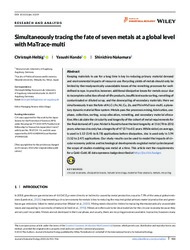Simultaneously tracing the fate of seven metals at a global level with MaTrace‐multi
DOI: https://doi.org/10.1111/jiec.13219
Persistent URL: http://resolver.sub.uni-goettingen.de/purl?gldocs-11858/10229
Persistent URL: http://resolver.sub.uni-goettingen.de/purl?gldocs-11858/10229
Supplement: https://doi.org/10.17605/OSF.IO/R54C6
Helbig, Christoph; Kondo, Yasushi; Nakamura, Shinichiro, 2022: Simultaneously tracing the fate of seven metals at a global level with MaTrace‐multi. In: Journal of Industrial Ecology, Band 26, 3: 923 - 936, DOI: 10.1111/jiec.13219.
 |
Dokument öffnen: |
Keeping materials in use for a long time is key to reducing primary material demand and environmental impacts of resource use. Recycling yields of metals should only be limited by thermodynamically unavoidable losses of the remelting processes for well‐defined scraps. In practice, however, additional dissipative losses for metals occur due to incomplete collection of end‐of‐life products, insufficient waste sorting, remelting of contaminated or diluted scrap, and the downcycling of secondary materials. Here we simultaneously trace the fate of Al, Cr, Fe, Ni, Cu, Zn, and Pb in MaTrace‐multi, a planetary dynamic material flow system. Metals pass the processes mining, fabrication, use‐phase, collection, sorting, scrap allocation, remelting, and secondary material allocation. We calculate the circularity and longevity of the cohort of metal requirements for the final demand of 1 year. Nickel is found to have the best longevity at 116 (78 to 205) years, whereas zinc only has a longevity of 47 (37 to 61) years. While nickel, on average, is used in 5.13 (3.45 to 8.78) applications before dissipation, zinc is used only in 1.94 (1.52 to 2.47) applications. Our study results can be used to model the impacts of circular economy policies and technological developments on global metal cycles beyond the scope of studies modeling one metal at a time. This article met the requirements for a Gold–Gold JIE data openness badge described at http://jie.click/badges
Statistik:
ZugriffsstatistikSammlung:
Schlagworte:
circular economydissipative losses
industrial ecology
material flow analysis
metals
recycling
This is an open access article under the terms of the Creative Commons Attribution‐NonCommercial License, which permits use, distribution and reproduction in any medium, provided the original work is properly cited and is not used for commercial purposes.

